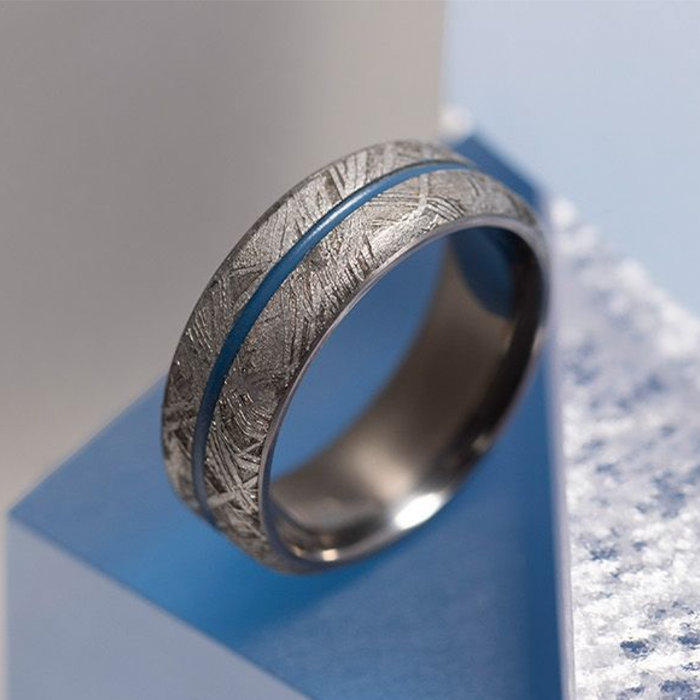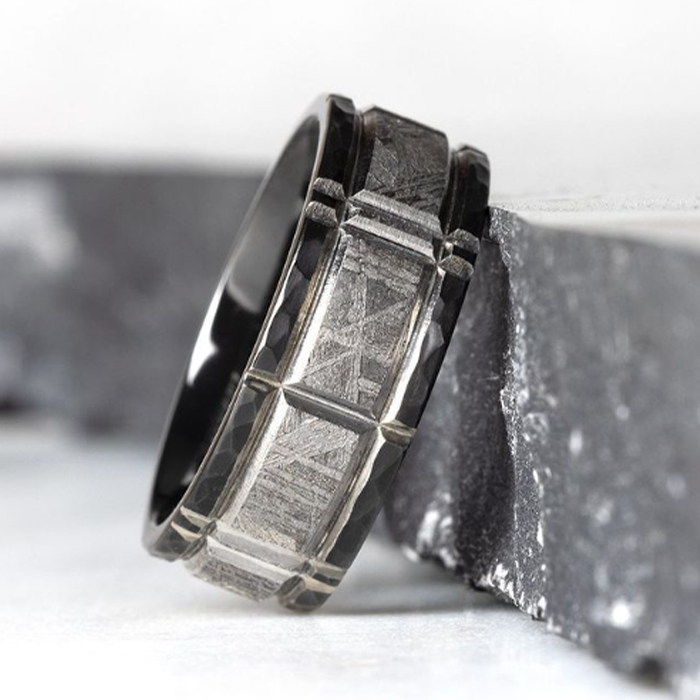Consider two people, drawn together by an undeniable attraction. Yesterday they were strangers; today they are on a unique journey – a journey that will determine who they become together. As two worlds collide, love can happen in an instant. But, the foundation for a lifelong relationship takes much longer to solidify.
The lovers’ journey – from initial meeting to marriage and beyond – is an apt metaphor for the authentic Gibeon meteorite used in our rings. This rare type of meteorite is composed of metals which were formed in a super-heated state and cooled over the course of 4 billion years. This slow cooling, or solidification, settled the molecules in a crystalline structure, similar to what you’d see in a diamond or gemstone. Not only does this rare phenomenon not occur naturally on Earth, but it’s also what gives the metal its distinctive, patterned look and priceless meaning.
Wear a meteorite ring and forever remember that what you and your loved one become over time is so much more than the attraction that initially brought you together.
Material Guide


Where is it from?
Gibeon meteorite was formed in space four billion years ago. It exploded upon entering Earth’s atmosphere, landing in the desert of Namibia, Africa in scattered pieces over an area 171 miles long and 62 miles wide.
The Namibian government banned the export of Gibeon meteorite, as any newly discovered pieces are automatically protected as national monuments. This means that any meteorite specimens in circulation are of increasing value and incredibly limited supply. As is true in general for Lashbrook, we source our materials as ethically as possible and our meteorite comes from that increasingly limited supply.
The origin and rarity of each meteorite ring makes it a distinctive piece of art.
Unique Characteristics
Gibeon meteorite features a distinct crystalline structure on its surface, a pattern found only in diamonds and gemstones. This visible crystal structure, or Widmanstätten pattern, was caused by extremely slow cooling of the material in space.
The Widmanstätten pattern will vary slightly between pieces, as will the presence of inclusions. Inclusions are dark spots or tiny holes on the surface of the meteorite that are often traces of metals that, in some cases, do not occur naturally on earth. These inclusions are an important clue to the meteorite’s origin and are identifiers of its authenticity.
The acid etching of the meteorite is the last step in the production of the ring. It is here where natural characteristics show themselves.
CUSTOMIZATION & PERSONALIZATION
We produce styles incorporating meteorite in contemporary metals, precious metals and combinations of the two. Meteorite can be inlaid in the center of a ring or off-center and in a round or square band. Choose from any one of our popular styles or design your own meteorite ring with our Lashbrook Builder.
WEAR & CARE
Despite its natural protection against rust, Gibeon meteorite is primarily composed of iron so oxidation is always a possibility. Exposure to strong oxidizing agents such as chlorine, bleach, or salt can increase the chance of rusting. These chemicals, found in strong household cleaners, pools, hot tubs, and salt water, should be avoided. We are continually embracing new research and technology. In May 2017, we had an evolution in the way we treat meteorite that will continue to minimize the possibility of rust. If rust does appear, it can easily be removed.
Cleaning: meteorite rings can be cleaned with soap and water. These rings can be sent into us to be factory refinished and resealed (refurbishment).
UNIQUE FEATURES
FAQs
What type of meteorite does Lashbrook use in wedding rings?
Where does Lashbrook source meteorite?
Will the meteorite pattern fade?
What is the likelihood that the meteorite will rust over time?










